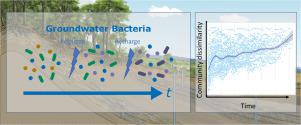Water Research ( IF 11.4 ) Pub Date : 2021-05-26 , DOI: 10.1016/j.watres.2021.117290 Lijuan Yan 1 , Syrie M Hermans 2 , Kai Uwe Totsche 3 , Robert Lehmann 3 , Martina Herrmann 1 , Kirsten Küsel 1

|
Time series analyses are a crucial tool for uncovering the patterns and processes shaping microbial communities and their functions, especially in aquatic ecosystems. Subsurface aquatic environments are perceived to be more stable than surface oceans and lakes, due to the lack of sunlight, the absence of photosysnthetically-driven primary production, low temperature variations, and oligotrophic conditions. However, periodic groundwater recharge should affect the structure and succession of groundwater microbiomes. To disentangle the long-term temporal changes in bacterial communities of shallow fractured bedrock groundwater, and identify the drivers of the observed patterns, we analysed bacterial 16S rRNA gene sequencing data for samples collected monthly from three groundwater wells over a six-year period (n = 230) along a hillslope recharge area. We showed that the bacterial communities in the groundwater of limestone-mudstone alternations were not stable over time and exhibited non-linear dissimilarity patterns which corresponded to periods of groundwater recharge. Further, we observed an increase in dissimilarity over time (generalized additive model P < 0.001) indicating that the successive recharge events result in communities that are increasingly more dissimilar to the initial reference time point. The sampling period was able to explain up to 29.5% of the variability in bacterial community composition and the impact of recharge events on the groundwater microbiome was linked to the strength of the recharge and local environmental selection. Many groundwater bacteria originated from the recharge-related sources (mean = 66.5%, SD = 15.1%) and specific bacterial taxa were identified as being either enriched or repressed during recharge events. Overall, similar to surface aquatic environments, the microbiomes in shallow fractured-rock groundwater vary through time, though we revealed groundwater recharges as unique driving factors for these patterns. The high temporal resolution employed here highlights the dynamics of bacterial communities in groundwater, which is an essential resource for the provision of clean drinking water; understanding the biological complexities of these systems is therefore crucial.
中文翻译:

地下水细菌群落随着时间的推移而进化以响应补给
时间序列分析是揭示塑造微生物群落及其功能的模式和过程的重要工具,尤其是在水生生态系统中。由于缺乏阳光、缺乏光合驱动的初级生产、低温变化和贫营养条件,人们认为地下水生环境比地表海洋和湖泊更稳定。然而,定期地下水补给会影响地下水微生物群落的结构和演替。为了解开浅层裂隙基岩地下水细菌群落的长期时间变化,并确定观察到的模式的驱动因素,我们分析了 6 年期间每月从三个地下水井收集的样本的细菌 16S rRNA 基因测序数据(n = 230) 沿山坡补给区。我们表明,石灰岩-泥岩交替的地下水中的细菌群落随着时间的推移不稳定,并表现出与地下水补给周期相对应的非线性差异模式。此外,我们观察到不相似性随时间增加(广义加性模型P< 0.001) 表明连续的补给事件导致社区与初始参考时间点越来越不同。采样期能够解释高达 29.5% 的细菌群落组成变异,补给事件对地下水微生物群的影响与补给强度和当地环境选择有关。许多地下水细菌源自与补给相关的来源(平均值 = 66.5%,SD = 15.1%),并且特定细菌分类群被确定为在补给事件期间被富集或抑制。总体而言,与地表水环境类似,浅层裂隙岩地下水中的微生物群落随时间变化,尽管我们发现地下水补给是这些模式的独特驱动因素。这里采用的高时间分辨率突出了地下水中细菌群落的动态,这是提供清洁饮用水的重要资源;因此,了解这些系统的生物学复杂性至关重要。











































 京公网安备 11010802027423号
京公网安备 11010802027423号